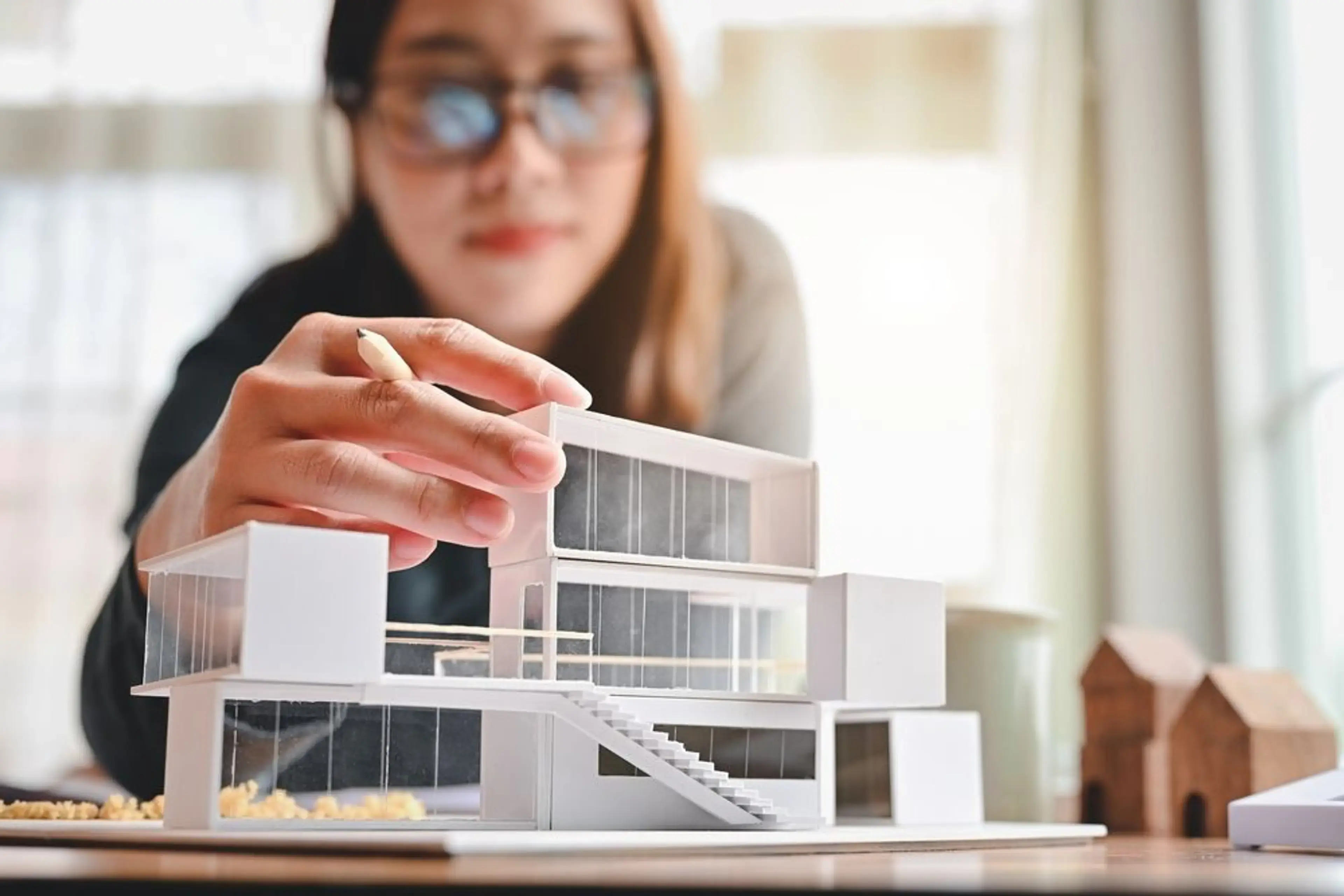Architect Salary Breakdown by City and Seniority
Architect Salary Breakdown by City and Seniority
Blog Article
Recognizing the Diverse Profession Paths Available for Aspiring Architect
As an ambitious Architect, you have a globe of career courses waiting for you. Each course provides one-of-a-kind difficulties and opportunities to use your creativity and technological expertise. Whether you're drawn to traditional design or the nuances of lasting style, there's a specific niche that straightens with your interests. Understanding these varied options can shape your specialist journey, however which instructions will you pick to explore first?
Standard Style: Creating Frameworks and structures
Traditional architecture concentrates on making structures and structures that blend performance with aesthetic charm. As you discover this area, you'll value the intricate balance between type and purpose. You'll learn to draw motivation from historical styles, integrating aspects like proportion, products, and workmanship. Your layouts can mirror social heritage, showcasing local traditions while satisfying modern-day demands.
You'll create abilities in drafting, model-making, and website evaluation, allowing you to visualize and interact your ideas successfully. Involving with customers, you'll require to recognize their vision and convert it right into practical layouts.
In addition, constructing codes and sustainability techniques are important in your work, ensuring your structures are environmentally pleasant and secure. As you expand in your career, you'll find possibilities in domestic, commercial, and even reconstruction jobs, each offering distinct challenges. Welcoming conventional architecture leads the way for a fulfilling occupation that pays homage to the past while shaping the future.
Urban Preparation: Shaping Communities and Public Spaces
As an ambitious Architect, you can play an important duty as a metropolitan planner, changing how areas engage and function. By utilizing community interaction strategies, you'll ensure that residents have a voice in forming their environment. And also, incorporating sustainable layout principles will certainly aid produce rooms that not only satisfy today's needs however also protect the future.
Duty of Urban Planners
While numerous may think of architects as the sole visionaries behind structures, city organizers play an essential duty in forming the more comprehensive landscape of neighborhoods and public areas. By working together with various stakeholders, you'll help design parks, transportation systems, and residential locations that promote social interaction and accessibility. Your competence in spatial style and community characteristics permits you to picture future development while protecting cultural heritage.
Community Involvement Methods
Reliable neighborhood interaction techniques are crucial for metropolitan coordinators to ensure that the voices of locals are listened to and valued in the planning process. To foster purposeful discussion, you should focus on open discussion forums and workshops where neighborhood members can share their ideas and problems. Use studies and social networks to reach a more comprehensive audience, making certain diverse perspectives are consisted of. Collaborating with neighborhood organizations can boost depend on and assist in deeper connections. It is necessary to supply clear information regarding proposed jobs and decision-making procedures, enabling homeowners to feel enlightened and empowered. By proactively paying attention and integrating comments, you'll develop areas that mirror the community's demands, eventually leading to even more lasting and effective urban settings. Accept openness and continuous dialogue for long-term influence.
Sustainable Design Concepts
When creating metropolitan spaces, incorporating lasting layout concepts is important for producing atmospheres that thrive both environmentally and socially. Take into consideration incorporating eco-friendly spaces, like parks and gardens, to improve biodiversity and improve air quality.
Creating with water conservation in mind is also essential-- consider rainfall gardens and absorptive surface areas to manage stormwater. Entailing neighborhood participants throughout the planning process warranties that the rooms you produce fulfill their needs and motivate social communication. By accepting these concepts, you'll add to vibrant, sustainable city landscapes that profit everyone.

Landscape Architecture: Developing Lasting Exterior Atmospheres
As you discover landscape architecture, you'll find essential layout principles that create practical and stunning exterior areas. Sustainable practices play a crucial function in making sure these environments grow while decreasing environmental influence. Plus, you'll find a range of profession possibilities that enable you to make a real distinction in exactly how people connect with nature.
Style Principles in Landscape
Comprehending style concepts in landscape style is important for producing sustainable outside environments that harmonize with nature. You'll need to contemplate aspects like range, balance, and proportion to guarantee your designs feel cohesive and inviting. In addition, pay interest to seasonal changes, designing with materials that match the surroundings year-round.
Sustainable Practices Review
Lasting techniques in landscape design not just focus on aesthetics yet also prioritize eco-friendly wellness and source preservation. You can make rooms that advertise dirt health and wellness, such as making use of organic materials and exercising permaculture principles. Eventually, these techniques ensure your layouts profit both people and the environment for years to come.
Occupation Opportunities Expedition
With a strong foundation in sustainable practices, landscape architecture uses a range of job paths that allow you to make a significant influence on the environment. You might work as a landscape designer, producing visually pleasing and practical exterior rooms, or specialize in ecological remediation, assisting to restore broken communities. Urban coordinators usually team up with landscape engineers to develop green areas in urban settings, enhancing city livability. If you're enthusiastic regarding education, consider coming to be a landscape style instructor, motivating future generations. In addition, you could deal with nonprofits concentrated on environmental sustainability or participate in study to innovate brand-new methods. Each course not just forms gorgeous settings yet additionally promotes a healthier planet for future generations.
Lasting Style: Concentrating on Eco-Friendly Practices
As you discover your career in style, accepting environment-friendly practices can establish you apart in a competitive area. Sustainable style concentrates on producing structures that reduce ecological impact while boosting occupant wellness. By incorporating sustainable products, energy-efficient systems, and sustainable structure techniques, you'll contribute to a greener future.
Start by acquiring expertise of green qualifications like LEED or BREEAM, which can reinforce your qualifications. Think about just how natural light, air flow, and thermal efficiency can enhance design. Team up with engineers and ecological specialists to innovate remedies that minimize waste and preserve resources.
Do not forget the significance of area participation-- appealing neighborhood stakeholders can inspire styles that integrate with the environment. As clients progressively prioritize sustainability, your know-how in eco-friendly techniques will certainly not only draw in jobs however additionally accomplish your interest for liable style. Embrace this important element of the occupation, and enjoy your occupation grow.
Historical Conservation: Securing and Bring Back Cultural Heritage
While you begin on your building trip, think about the crucial duty of historical conservation in preserving our cultural heritage. This field focuses on the protection and remediation of significant buildings, sites, and structures that tell the tales of our past. By participating in historical preservation, you'll help safeguard the building tradition that shapes community identity.
As a historical preservation Architect, you'll analyze historic importance and assess the problem of this post structures. You'll work very closely with chroniclers and conservationists to assure authentic reconstruction methods are employed. This occupation path enables you to blend imagination with research, allowing you to develop solutions that appreciate initial materials and workmanship.
Your work not just contributes to sustainability by recycling existing buildings but likewise cultivates a feeling of satisfaction within neighborhoods. Embracing this course will help you come to be a guardian of history, preserving the tales and aesthetic appeals that enhance our lives.
Inside Architecture: Enhancing Indoor Spaces
Historical conservation and interior design both share a dedication to enhancing the developed setting, but advice they concentrate on various facets. While historic preservation highlights keeping a structure's cultural and historical worth, interior design absolutely nos in on maximizing indoor areas for performance and aesthetics.
As a hopeful Architect, you'll locate that indoor architecture enables you to blend creative thinking with technical skills. You'll create rooms that not only look excellent however likewise advertise convenience and performance. This area entails understanding how light, color, and materials communicate within an area, influencing state of mind and functionality.
You'll service different jobs, from household homes to business workplaces, ensuring that each atmosphere satisfies the requirements of its passengers. By prioritizing customer experience, you can change insides right into motivating and practical rooms, making a substantial effect on exactly how people connect with their surroundings. Welcome the possibility to enhance interior atmospheres and form the means people function and live.
Industrial Style: Combining Capability With Visual Appeals
Industrial layout plays an essential function in developing products that effortlessly mix aesthetic appeals with capability, making sure that what you make use of everyday is not just aesthetically enticing but likewise functional. As an ambitious Architect, you might engage yourself in this field, concentrating on making every little thing from furniture to consumer electronics. Your work includes comprehending individual demands, products, and making procedures, permitting you to develop cutting-edge services that improve daily experiences.
In commercial style, you'll usually collaborate with designers, manufacturers, and online marketers, making sure that your styles are not only gorgeous but additionally practical. You'll learn to balance kind and function, focusing on use without sacrificing style. By sharpening your skills in mapping out, 3D modeling, and prototyping, you'll her explanation be well-appointed to bring your concepts to life. This career path uses a vibrant setting where creativity satisfies functionality, making it a fulfilling choice for architects thinking about forming the items of tomorrow.
Frequently Asked Inquiries
What Educational Certifications Do I Required to End Up Being an Architect?
To come to be a designer, you'll need a specialist level in architecture, generally a Bachelor's or Master's. In addition, you'll need to complete a teaching fellowship and pass the Architect Registration Exam to exercise legally.
Exist Accreditation Requirements for Various Architectural Job Paths?
Yes, there're accreditation requirements for numerous architectural courses. Architect. You'll need to pass tests, total teaching fellowships, and often pursue specialized training, relying on your selected emphasis, like landscape architecture, city style, or historical preservation
What Software Abilities Are Vital for Architects Today?

Just How Can I Gain Practical Experience While Examining Style?
You can get useful experience by interning at architectural companies, taking part in layout competitions, offering for neighborhood projects, or teaming up with classmates on real-world assignments. These possibilities improve your skills and construct important links in the industry.
What Work Opportunities Exist Outside Typical Architecture Firms?
You can discover various work opportunities outside standard architecture firms, like city preparation, interior decoration, landscape design, building and construction administration, realty development, and even roles in sustainability consulting. Each deals distinct difficulties and incentives.
Whether you're drawn to traditional style or the subtleties of sustainable design, there's a niche that straightens with your passions.When creating city rooms, integrating lasting style concepts is vital for developing environments that prosper both environmentally and socially.As you discover landscape architecture, you'll find necessary design concepts that develop beautiful and functional exterior rooms.Understanding design principles in landscape design is necessary for developing sustainable outdoor environments that harmonize with nature.In industrial design, you'll typically work together with engineers, manufacturers, and online marketers, guaranteeing that your designs are not only stunning but also feasible.
Report this page